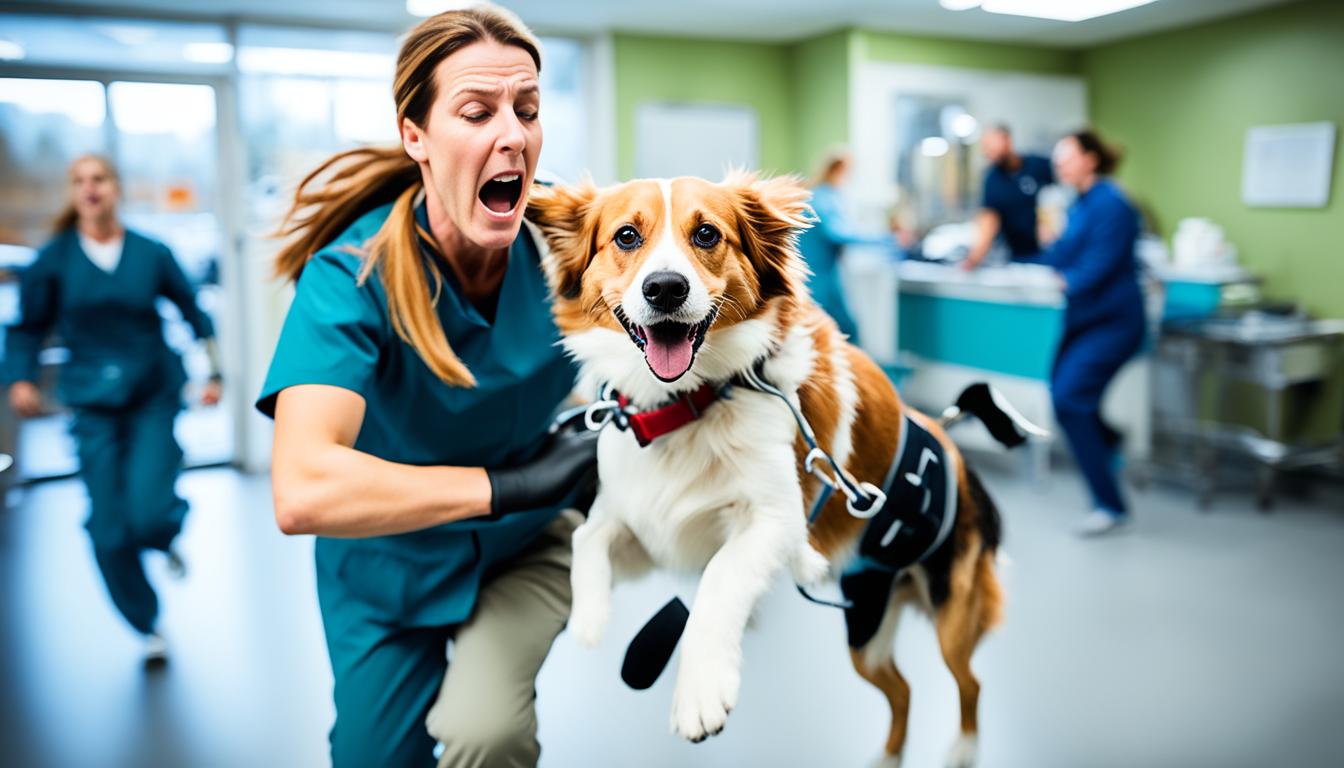Emergency veterinary care is crucial in ensuring the health and well-being of your pet during a crisis. By understanding the urgency in veterinary care and having the necessary emergency pet care essentials, you can take the lead in providing rapid response strategies and life-saving insights for your furry companion.
When it comes to your pet’s emergency care, every second counts. Being prepared and equipped with the right knowledge and resources can make all the difference in critical situations. From recognizing signs of pet emergencies to administering swift first aid and accessing emergency vet services, taking proactive steps can significantly increase the chances of a positive outcome for your beloved pet.
Key Takeaways:
- Emergency veterinary care is essential for ensuring the well-being of your pet during a crisis.
- Recognizing signs of pet emergencies is crucial in providing timely care.
- Having a well-stocked pet first aid kit and knowing how to perform CPR can make a difference in critical situations.
- Research and identify nearby emergency vet services and resources for quick access.
- Preparedness and collaboration with EMS can greatly enhance the outcome of pet emergencies.
Recognizing signs of pet emergencies
As a responsible pet owner, it is essential to be able to recognize the signs of pet emergencies. By being aware of these indicators, you can take immediate action and provide your pet with the necessary emergency care. Here are some common signs to watch out for:
- Difficulty breathing: Rapid or labored breathing, gasping for air, or wheezing can indicate a respiratory emergency.
- Sudden changes in behavior: If your pet becomes lethargic, disoriented, aggressive, or unusually withdrawn, it may signal an underlying problem that requires immediate attention.
- Severe bleeding: Excessive bleeding that doesn’t stop can be a life-threatening situation. Apply pressure, elevate the wound, and seek veterinary help right away.
- Vomiting or diarrhea: Persistent vomiting or diarrhea, particularly if accompanied by dehydration, lethargy, or blood in the stool, may indicate a serious gastrointestinal issue.
- Loss of consciousness: If your pet collapses or loses consciousness, it is a critical emergency. Perform CPR if necessary and rush them to the nearest veterinary clinic.
By recognizing these signs, you can promptly respond to pet emergencies and ensure your furry friend receives the necessary attention and care. Don’t hesitate to contact your veterinarian or an emergency veterinary clinic if you observe any of these symptoms.
Early recognition and intervention in pet emergencies can be life-saving. Act swiftly and don’t hesitate to seek professional help.
Remember, the ability to recognize signs of pet emergencies goes hand in hand with having the necessary emergency pet care essentials. In the next section, we will explore the essential items you should have on hand to provide immediate care to your beloved companion.
Swift and effective first aid for pets
In times of pet emergencies, swift and effective first aid can be crucial in ensuring the well-being and survival of your beloved companion. By having the necessary emergency pet care essentials and knowledge, you can provide immediate assistance until professional veterinary care is available.
Well-Stocked Pet First Aid Kit
A well-stocked pet first aid kit is an essential component of emergency preparedness. It should contain items such as:
- Bandages and gauze
- Antiseptic wipes
- Tweezers
- Scissors
- Saline solution
- Disposable gloves
- Emergency contact numbers
Having these emergency pet care essentials readily available can help you quickly address minor injuries and stabilize your pet’s condition.
Understanding CPR for Pets
Knowing how to perform CPR (cardiopulmonary resuscitation) on pets is a valuable skill that can save lives. CPR may be necessary in cases of cardiac arrest or respiratory distress. If your pet is unresponsive and not breathing, you can perform CPR by following these steps:
- Place your pet on a flat surface.
- Check for a pulse and breathing.
- If your pet has no pulse or is not breathing, begin chest compressions and artificial respiration.
- Continue CPR until your pet resumes breathing or you reach professional help.
Remember to maintain a steady rhythm and seek veterinary assistance as soon as possible.
Basic Wound Care
In cases of cuts, bites, or other injuries, knowing how to provide basic wound care can minimize the risk of infection and further complications.
Remember, any approach to wound care should only be done if your pet is not aggressive and it is safe to do so. If your pet is in severe pain or exhibits aggressive behavior, do not attempt to intervene and wait for professional help.
To clean a wound:
- Gently rinse the wound with saline solution or clean water.
- Apply an antiseptic solution or wipe to prevent infection.
- Cover the wound with gauze or a clean cloth to protect it.
Always consult with a veterinarian for further guidance and proper treatment of your pet’s wounds.
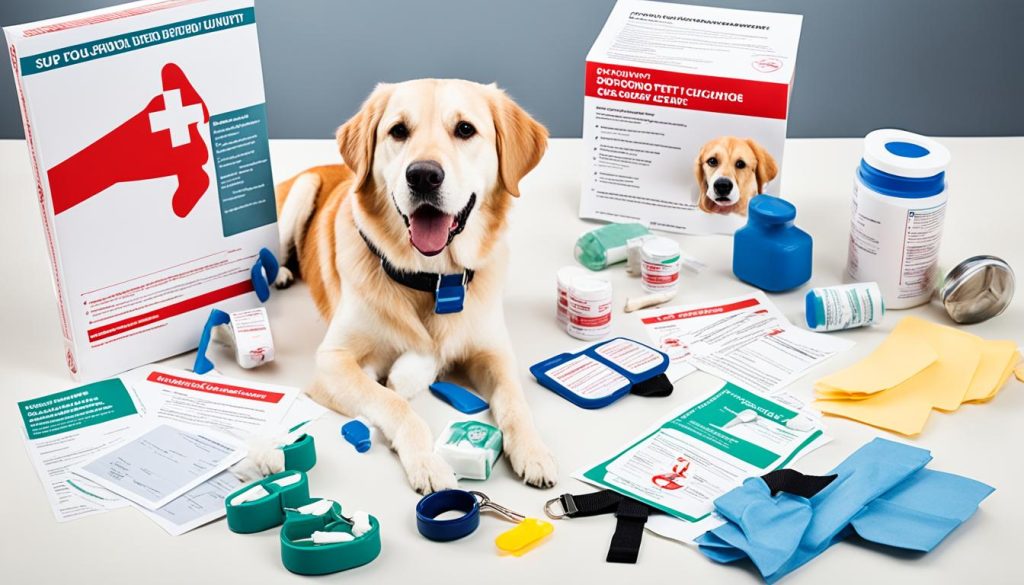
Incorporating these swift and effective first aid techniques into your emergency pet care essentials can make a significant difference when responding to pet emergencies. However, it is important to remember that first aid is not a substitute for professional veterinary care. Seek immediate veterinary attention for serious or life-threatening emergencies.
Emergency vet services and resources
In times of pet emergencies, immediate access to emergency vet services and resources is crucial. Being prepared and well-informed can make all the difference in ensuring the well-being of your furry companion. Here are some essential emergency pet care essentials and resources that you should have at your disposal:
1. Research and identify nearby emergency veterinary clinics
When a pet emergency arises, it’s important to know where to go for immediate professional help. Research and identify emergency veterinary clinics in your area that provide 24/7 care. Note down their contact information and keep it readily available for quick reference.
2. Online resources and helplines
In addition to emergency clinics, online resources and helplines can provide valuable guidance and advice during stressful situations. Familiarize yourself with reputable websites and helplines that offer reliable information on pet emergencies. These resources can assist you in making informed decisions and taking appropriate actions.
3. Pet insurance coverage
Having pet insurance coverage can provide financial assistance during emergency situations. Make sure to review your pet insurance policy and understand the coverage it offers. If you haven’t already, consider getting pet insurance to help alleviate the financial burden of unexpected medical expenses.
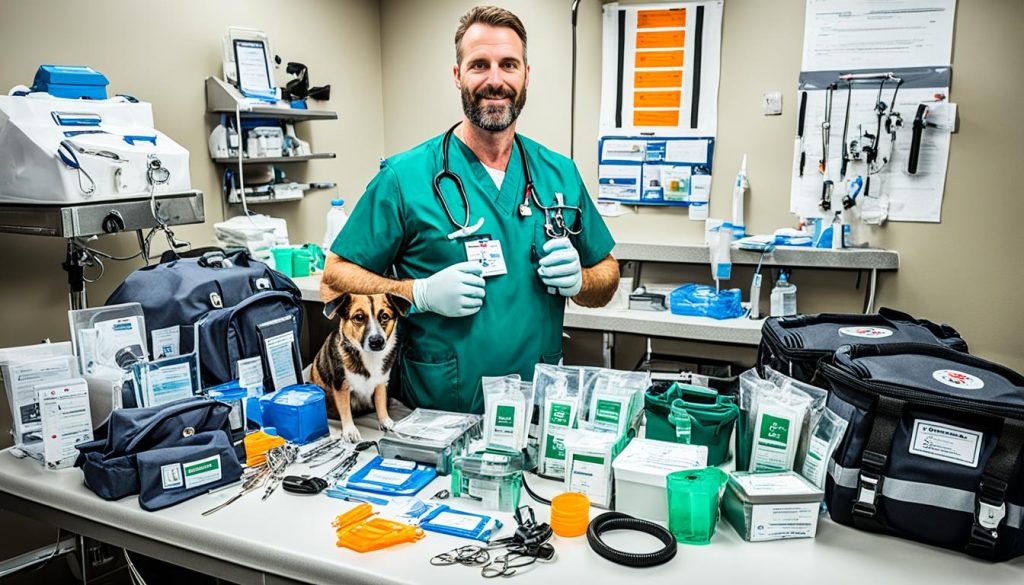
By having these emergency pet care essentials and resources readily available, you can be better equipped to handle pet emergencies with confidence and ensure that your pet receives the care they need in a timely manner.
Importance of preparedness in emergency veterinary care
When it comes to emergency veterinary care, preparedness can make all the difference in ensuring the well-being of your furry friend. By taking proactive measures and incorporating emergency pet care essentials into your routine, you can be better equipped to handle unexpected situations swiftly and effectively.
One essential aspect of preparedness is pet-proofing your home. This means creating a safe environment for your pet by securing harmful substances, keeping potentially dangerous objects out of reach, and ensuring that your home is free from hazards that could cause accidents or injuries. By making your home pet-friendly, you can significantly reduce the risk of emergencies.
In addition to pet-proofing, it is crucial to keep a list of emergency contacts readily available. This includes the contact information of your regular veterinarian, as well as local emergency veterinary clinics that offer 24/7 care. Having these numbers on hand will allow you to seek immediate assistance when needed, without wasting precious time searching for contact details.
Furthermore, having a designated pet caregiver in case of your absence is another important aspect of preparedness. Whether it’s a trusted friend, family member, or professional pet sitter, having someone who can step in and provide care for your pet during an emergency situation is essential. Make sure to communicate your expectations and emergency plans with your designated caregiver in advance, so they are well-prepared to assist your pet if the need arises.
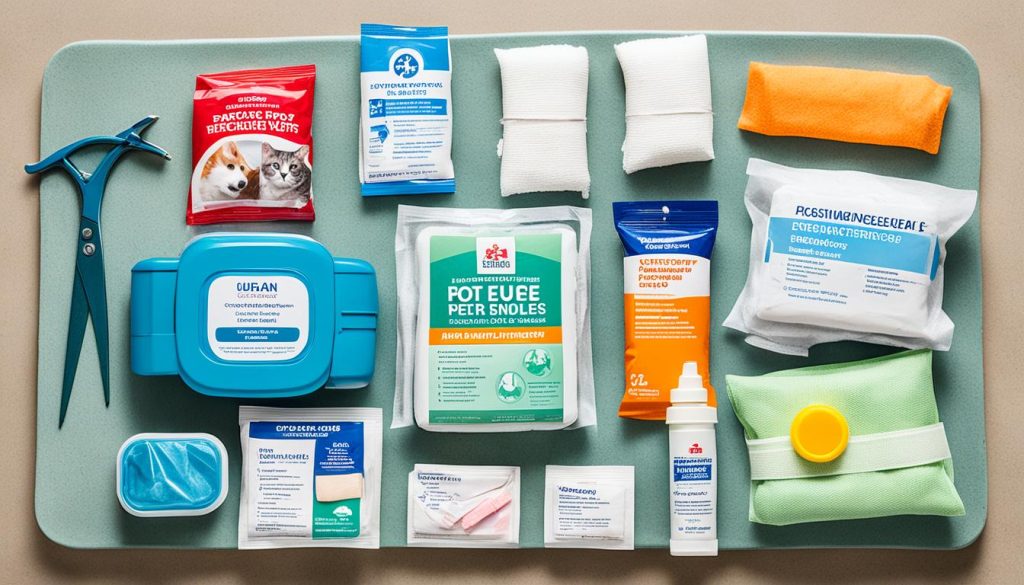
“Being prepared is half the battle. By pet-proofing your home, having a list of emergency contacts, and designating a caregiver, you can stay ahead in emergency veterinary care.”
By incorporating these emergency pet care essentials into your daily life, you can enhance your ability to respond quickly and effectively in times of crisis. Remember, preparation is key when it comes to emergency veterinary care, and it is always better to be proactive than reactive.
Role of EMS in pet emergencies
When a pet emergency occurs, it is essential to have access to the right medical assistance as quickly as possible. This is where Emergency Medical Services (EMS) come into play. They play a vital role in providing immediate care and resources for pets in crisis situations. By understanding the urgency in veterinary care and having the necessary emergency pet care essentials, you can collaborate effectively with EMS to ensure the best possible outcome for your beloved companion.
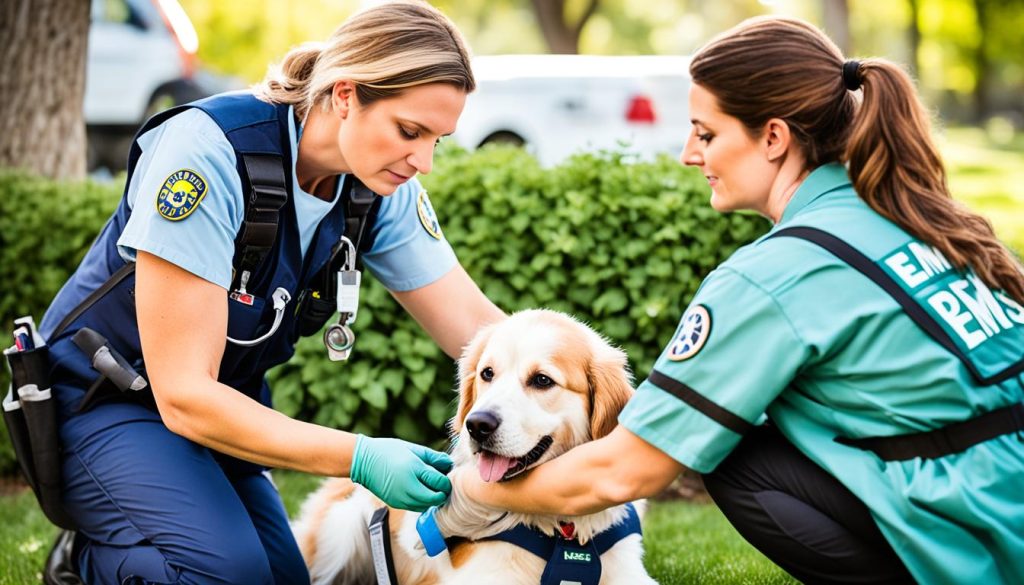
EMS personnel are equipped with the skills and resources needed to provide on-the-spot medical assistance to pets in critical condition. Whether it’s administering life-saving interventions or stabilizing pets before transporting them to veterinary clinics, EMS plays a crucial role in the chain of care during pet emergencies.
“EMS personnel are trained to handle a wide range of emergencies and are familiar with the specific needs of pets in crisis. Their expertise and actions can make a significant difference in the outcome of a pet emergency.”
By working collaboratively with EMS, you can ensure that your pet receives the immediate attention and care they need. It’s important to have a clear understanding of the emergency pet care essentials and be prepared to provide valuable information to EMS personnel, such as your pet’s medical history and any observed symptoms.
Furthermore, understanding the role of EMS in pet emergencies can help you effectively communicate your concerns, ask relevant questions, and participate in decision-making alongside the EMS team. This collaborative approach enhances the level of care provided to your pet during this critical time.
Collaborating with EMS in Pet Emergencies
| Ways to Collaborate with EMS | Benefits |
|---|---|
| Provide accurate information about your pet’s condition | Allows EMS to prioritize care and make informed decisions |
| Follow the instructions provided by EMS | Ensures that interventions can be administered smoothly |
| Communicate any changes in your pet’s condition during transport | Enables EMS to adapt their care plan and update receiving veterinary clinics |
| Ask questions and seek clarification | Helps you understand the process and make informed decisions |
| Express any concerns or preferences regarding your pet’s care | Allows for personalized and compassionate care |
This collaborative effort between pet owners and EMS is crucial in ensuring that your pet receives the best possible care during an emergency. By working together, you can optimize the chances of a successful outcome and provide your pet with the timely assistance they need to recover.
Strategies to improve cardiac arrest survival in pets
In the event of a cardiac arrest, time is of the essence when it comes to saving your pet’s life. By familiarizing yourself with emergency pet care essentials and being prepared to take immediate action, you can significantly increase the chances of survival for your furry companion.
Rapid recognition of cardiac arrest is crucial. Look for signs such as sudden collapse, loss of consciousness, absence of breathing or pulse, and pale or bluish gums. If you suspect cardiac arrest, act quickly and decisively.
Early CPR (Cardiopulmonary Resuscitation) can make a lifesaving difference. The American Veterinary Medical Association (AVMA) recommends performing chest compressions and artificial respiration if your pet’s heart has stopped. Check for a pulse, and if absent, initiate CPR immediately.
“Performing CPR on pets can be a daunting task, but it can truly be a lifesaver. Proper training, such as a pet CPR course, can provide you with the knowledge and confidence to administer effective CPR when every second counts.”
If applicable, prompt defibrillation using an automated external defibrillator (AED) may be necessary. An AED helps restore a normal heart rhythm by delivering an electric shock. However, it’s important to note that AEDs designed for human use may not be suitable for pets. Consult with a veterinarian for guidance on pet-specific defibrillation equipment.
Effective advanced cardiac life support (ACLS) is another critical aspect of improving survival chances. This may involve administering medications, such as epinephrine, to stimulate the heart or using advanced airway management techniques to ensure adequate oxygenation and ventilation.
Integrated post-resuscitative care is essential
After successfully resuscitating your pet, it’s vital to provide integrated post-resuscitative care to optimize their chances of recovery. This includes seeking immediate veterinary attention, monitoring vital signs, addressing potential underlying causes of the cardiac arrest, and ensuring a calm and stress-free environment.
Remember, every second counts when it comes to cardiac arrest in pets. By equipping yourself with the necessary emergency pet care essentials and having a well-thought-out plan in place, you can be better prepared to handle this critical situation and increase the likelihood of a positive outcome for your beloved companion.

Overview of EMS in pet emergencies
Emergency Medical Services (EMS) play a crucial role in providing emergency veterinary care for pets. With their expertise and specialized equipment, EMS personnel are trained to respond to various medical crises that pets may experience. Understanding the structure and organization of EMS, as well as the relevant personnel and oversight at different levels, is essential for pet owners in navigating the emergency veterinary care system effectively.
When a pet emergency arises, knowing how to access and communicate with EMS can make a significant difference in the outcome. By being familiar with the emergency pet care essentials, you can seek appropriate help promptly. Here is an overview of the different components of EMS in pet emergencies:
Emergency Veterinary Dispatch Center
The emergency veterinary dispatch center serves as the central hub for receiving and managing emergency calls related to pets. Trained operators at the dispatch center assess the severity of the situation and assign appropriate resources to respond to the emergency. They play a critical role in establishing timely communication between pet owners and EMS personnel.
Emergency Animal Ambulance
The emergency animal ambulance is a specialized vehicle equipped with medical equipment and supplies to provide on-site treatment and transport for injured or sick pets. EMS personnel in the animal ambulance are trained to administer basic veterinary care, stabilize the condition of the pet, and safely transport them to an emergency veterinary clinic for further treatment.
Emergency Veterinary Clinic
Emergency veterinary clinics are dedicated facilities that provide round-the-clock emergency care for pets. These clinics are equipped with advanced medical equipment and staffed by veterinarians experienced in handling urgent cases. When immediate veterinary intervention is required, pet owners can bring their pets to these clinics for comprehensive medical care.
Collaboration with Human EMS
In some cases, pet emergencies may occur simultaneously with human emergencies, such as natural disasters or accidents. In these situations, EMS personnel may collaborate with human EMS counterparts to coordinate rescue efforts and ensure the safety and well-being of both humans and pets.
By understanding the role of EMS in pet emergencies and being familiar with the emergency pet care essentials, pet owners can play an active part in ensuring the best possible care for their beloved pets. Remember that every second counts in an emergency, so it is important to stay calm, provide accurate information, and follow the instructions of EMS personnel.
| Benefits of EMS in Pet Emergencies | Examples |
|---|---|
| Immediate response and on-site treatment | Administering CPR to a pet in cardiac arrest |
| Safe transportation to emergency veterinary clinics | Transporting an injured pet with fractures to a clinic for surgical intervention |
| Access to specialized medical equipment and resources | Performing diagnostic imaging (X-rays, ultrasounds) to identify internal injuries |
| Collaboration with veterinary professionals | Consulting with veterinarians for expert advice during critical situations |
EMS personnel involved in pet emergency response
When a pet emergency strikes, it’s crucial to have a responsive and knowledgeable team of EMS personnel on hand to provide immediate medical care. From 911 call takers and emergency medical dispatchers to EMTs and paramedics, each member of the EMS team plays a vital role in ensuring the well-being of pets in crisis. Understanding the roles and responsibilities of these dedicated professionals is essential for pet owners in order to effectively communicate and collaborate during pet emergencies.
911 Call Takers
911 call takers are the first point of contact during a pet emergency. They assess the situation, gather critical information, and dispatch the appropriate EMS resources to the scene. These skilled professionals play a crucial role in ensuring a timely response and providing initial guidance to pet owners in distress.
Emergency Medical Dispatchers
Emergency medical dispatchers serve as a lifeline between pet owners and EMS personnel. They provide essential instructions over the phone, guiding pet owners through emergency procedures such as CPR or controlling bleeding until medical help arrives. Their calm demeanor and expertise are essential in navigating high-stress situations.
EMTs (Emergency Medical Technicians)
EMTs are trained in basic emergency medical care and play a vital role in stabilizing pets during transit to veterinary care facilities. They provide crucial interventions such as administering oxygen, immobilizing fractures, controlling bleeding, and monitoring vital signs. EMTs deliver essential pre-hospital care to help ensure the best possible outcome for pets in need.
Paramedics
Paramedics are highly trained medical professionals who possess advanced skills in emergency medical care. They are equipped to administer medication, perform advanced airway management, and provide intravenous therapy for critically ill or injured pets. Paramedics work closely with veterinarians and EMTs to deliver comprehensive and life-saving interventions.
Collaboration with EMS personnel is essential for pet owners during emergencies. By understanding the roles and responsibilities of each member of the EMS team, pet owners can effectively communicate their pet’s condition and expedite the delivery of appropriate care. These emergency pet care essentials form the foundation of a seamless and efficient pet emergency response.
Typical stressors for pet emergency response staff
Pet emergency response staff play a crucial role in providing immediate care and support during pet emergencies. However, their line of work comes with its own set of stressors that can impact their well-being and ability to effectively respond to emergencies. It is essential to recognize and address these stressors as vital emergency pet care essentials.
Some typical stressors faced by pet emergency response staff include:
- Personal experiences with the disaster: Responders may have their own experiences with the disaster, making it emotionally challenging to provide care while dealing with personal trauma.
- Direct exposure to the negative effects of the disaster: Witnessing injured or distressed pets can be emotionally and mentally distressing for response staff.
- Cumulative stress from repeatedly hearing survivors’ stories: Listening to survivors’ stories and witnessing their emotional distress can lead to cumulative stress and vicarious trauma.
- Feeling overwhelmed by the grief of others: Responders often encounter grieving pet owners, and the weight of their emotions can be overwhelming.
- Working long hours in challenging environments: Emergency response operations may involve working extended shifts in high-stress and unpredictable environments, leading to physical and mental exhaustion.
Recognizing these stressors and implementing measures to address them is crucial for the well-being of pet emergency response staff and their ability to provide effective support during pet emergencies.
To alleviate stress and support the mental health of response staff, organizations can:
- Provide sufficient breaks and rest periods during intense response operations.
- Offer counseling services and mental health support for staff members.
- Encourage staff to practice self-care activities and prioritize their mental well-being.
- Implement debriefing sessions and peer support programs for staff to share their experiences and emotions.
- Ensure clear communication channels to address concerns and provide updates to staff members.
| Typical Stressors | Impact | Recommended Solutions |
|---|---|---|
| Personal experiences with the disaster | Emotional challenges Mental health issues |
Provide counseling services for staff Encourage open communication and peer support |
| Direct exposure to negative effects of the disaster | Emotional distress Compassion fatigue |
Implement stress management programs Offer mental health resources |
| Cumulative stress from hearing survivors’ stories | Cumulative stress Vicarious trauma |
Provide access to counseling services Facilitate debriefing sessions |
| Feeling overwhelmed by the grief of others | Emotional burden Compassion fatigue |
Encourage self-care practices Offer emotional support resources |
| Working long hours in challenging environments | Physical exhaustion Mental fatigue |
Implement shift rotation schedules Provide rest and recovery periods |
By recognizing and addressing the stressors faced by pet emergency response staff, organizations can ensure the well-being of their dedicated responders and their ability to provide effective support during pet emergencies.
Individual approaches to stress management in pet emergency response
Managing stress is crucial for pet emergency response staff to maintain their well-being and effectiveness. In high-pressure situations, it is essential to have emergency pet care essentials that can help alleviate stress and ensure optimal care for pets in crisis. Here are some individual approaches that can aid in stress management:
- Self-awareness: Recognize your own stress triggers and implement self-care practices to maintain your mental and emotional well-being.
- Workload management: Prioritize tasks and delegate responsibilities, if possible, to prevent overwhelm and maintain a healthy work-life balance.
- Maintaining a balanced lifestyle: Engage in activities outside of work that bring you joy and relaxation. This can include spending time with loved ones, exercising, pursuing hobbies, or practicing mindfulness and meditation.
- Practicing stress-reduction techniques: Explore stress-relief techniques such as deep breathing exercises, progressive muscle relaxation, or journaling to help manage anxiety and promote a sense of calm.
- Access to effective supervision and training: Ensure that you have access to supportive supervisors or mentors who can provide guidance and help navigate challenging situations. Additionally, ongoing training and professional development opportunities can enhance your skills and confidence in handling pet emergencies.
By implementing these strategies, pet emergency response staff can better cope with the demands of their work and provide optimal care to pets in crisis. It is crucial to prioritize your own well-being to ensure that you can continue to provide the highest level of emergency pet care.
“Taking care of yourself is part of taking care of others.”
| Stress Management Techniques | Benefits |
|---|---|
| Prioritizing self-care | Reduces burnout and improves overall well-being |
| Engaging in leisure activities | Provides a healthy outlet for stress and promotes work-life balance |
| Practicing mindfulness | Reduces anxiety and increases focus and resilience |
| Seeking support from supervisors or mentors | Offers guidance and assistance during challenging situations |
| Pursuing ongoing training and professional development | Enhances skills and confidence in emergency pet care |
Conclusion
Emergency veterinary care is an essential component of responsible pet ownership. Understanding the urgency in veterinary care and having the necessary emergency pet care essentials can make a significant difference in the outcome of a crisis. By being prepared to take immediate action, you become your pet’s first line of defense in times of emergency.
Collaborating with Emergency Medical Services (EMS) and having access to emergency vet services and resources further enhances the chances of a positive outcome for your beloved pet. Make sure to familiarize yourself with nearby emergency veterinary clinics that provide 24/7 care and keep their contact information readily available. Additionally, staying proactive and well-informed about pet emergency care is crucial in providing the best possible veterinary care for your furry companion.
Remember, emergencies can happen unexpectedly, and being prepared can save precious time and potentially save your pet’s life. By recognizing the urgency in veterinary care, understanding the emergency pet care essentials, and staying proactive, you can ensure that your pet receives the immediate attention and care they need in times of crisis.
FAQ
Why is emergency veterinary care important?
What are the signs of pet emergencies?
How can I provide swift and effective first aid for my pet?
How can I access emergency vet services and resources?
Why is preparedness important in emergency veterinary care?
What role does EMS play in pet emergencies?
How can I improve cardiac arrest survival in my pet?
What is the overview of EMS in pet emergencies?
Who are the EMS personnel involved in pet emergency response?
What are the typical stressors for pet emergency response staff?
How can pet emergency response staff manage stress?
How can I provide the best emergency veterinary care for my pet?
Source Links
- https://www.samhsa.gov/dtac/disaster-response-template-toolkit/disaster-responder-stress-management
- https://www.ncbi.nlm.nih.gov/books/NBK321505/
- https://www.who.int/our-work/health-emergencies
